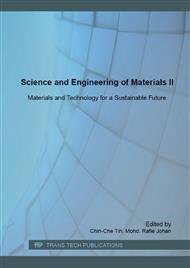[1]
Malaysia palm oil industry (2013).
Google Scholar
[2]
A. S. Ahmed, M.A. Alam, A. Pieel, M.R. Rahman, and S. Hamdan, Study of Physical and Mechanical Properties of Oil Palm Empty Fruit Bunch Fiber Reinforced Polypropylene Composites, Energy Environ. 2 (2010) 16-21.
Google Scholar
[3]
L. Wang, X. Dong, H. Jiang, G. Li and M. Zhang, Preparation of a novel carbon-based solid acid from cassava stillage residue and its use for the esterification of free fatty acids in waste cooking oil, Bioresource Technol. 158 (2014) 392-395.
DOI: 10.1016/j.biortech.2014.02.132
Google Scholar
[4]
F. L. Pua, Z. Fang, S. Zakaria, F. Guo, and C. H. Chia, Direct production of biodiesel from high-acidvalue Jatropha oil with solid acid catalyst derived from lignin, Biotechnol. Biofuel. 4 (2011) 1-8.
DOI: 10.1186/1754-6834-5-66
Google Scholar
[5]
M.S. Sajab, C.H. Chia, S. Zakaria, S.M. Jani, M.K. Ayob, K.L. Chee, P.S. Khiew and W.S. Chiu, Citric acid modified kenaf core fibres for removal of methylene blue from aqueous solution, Bioresource Technol. 102 (2011) 7237-7243.
DOI: 10.1016/j.biortech.2011.05.011
Google Scholar
[6]
A. Takagaki, M. Toda, M. Okamura, J.N. Kondo, S. Hayashi, K. Domen and M. Hara, Esterification of higher fatty acids by a novel strong solid acid, Catal. Today. 116 (2006) 157-161.
DOI: 10.1016/j.cattod.2006.01.037
Google Scholar
[7]
A.A. Refaat, Biodiesel production using solid metal oxide catalysts, Environ. Sci. 8 (2011) 203-221.
Google Scholar
[8]
Z. Yaakob, I.R. Sukarman, B. Narayanan, S.R. Sheikh Abdullah and M. Ismail, Utilization of palm empty bunch for the production of biodiesel from Jatropha curcas oil, Bioresource Technol. 104 (2012) 695-700.
DOI: 10.1016/j.biortech.2011.10.058
Google Scholar
[9]
M. Dokic, Z. Kesic, J. Krstic, D. Jovanovic and D. Skala, Decrease of free fatty acid content in vegetable oil using silica supported ferric sulfate catalyst, Fuel. 97 (2012) 595-602.
DOI: 10.1016/j.fuel.2012.03.039
Google Scholar
[10]
M. Gotic and S. Music, Mossbauer, FT-IR and FE SEM investigation of iron oxides precipitated from FeSO4 solutions, J. Mol. Struct. 834-836 (2007) 445-453.
DOI: 10.1016/j.molstruc.2006.10.059
Google Scholar
[11]
M.J. Ariza, D.J. Jones and J. Roziere, Role of post-sulfonation thermal treatment in conducting and thermal properties of sulfuric acid sulfonated poly (benzimidazole) membranes, Desalination, 147, (2002) 183-189.
DOI: 10.1016/s0011-9164(02)00532-5
Google Scholar
[12]
Z. Gao, S. Tang, X. Cui, S. Tian and M. Zhang, Efficient mesoporous carbon-based solid catalyst for the esterification of oleic acid, Fuel. 140, (2015) 669-676.
DOI: 10.1016/j.fuel.2014.10.012
Google Scholar


